Way Down Deep I Revel Performa B15
Widely acknowledged as one of the country's most talented speaker engineers, Revel's Kevin Voecks is a veteran of small, specialty speaker companies, but he now enjoys the research and manufacturing resources of a nearly $3 billion parent company—Harman International—which also owns Lexicon, Mark Levinson, Infinity, JBL, BSS, Crown, Studer, and others.
Measurements
Frequency response at 80dB (Fig.1): 20–100Hz, +/-1.7dB; 24–100Hz, +/-0.5dB; –5.7dB at 18Hz
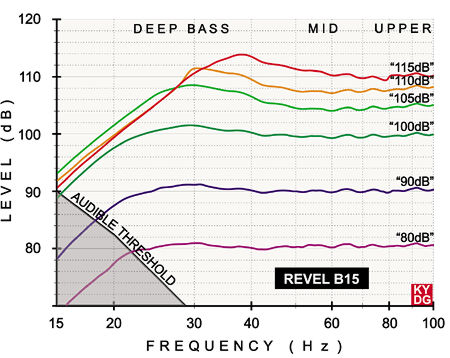
Fig. 1: Frequency Response vs Output
Frequency response at higher levels: The response shape became less flat at progressively higher levels, with a bulge appearing at around 30Hz (see Fig.1). At the 105dB level, for example, output at 30Hz was nearly 4.5dB stronger than at 60Hz. Not surprisingly, support for the very lowest frequencies faded at the higher playback levels: No matter how much pedal I gave it, the 20 and 25Hz output levels were limited, presumably by the internal protection circuitry, to 101 and 107dB, respectively, during the 35-second sinewave sweeps.
Dynamic range: The B15's most prominent measured idiosyncrasy turned out to be in the way it handled dynamics. The power compression curves in Fig.2 are all normalized to the 90dB response; that is, the power compression figures on the left (y-axis) show only the changes in the response relative to the subwoofer's 90dB output. As shown in the 105dB (light green) trace, there was an unusual excursion into greater-than-unity values around 30Hz, indicating "negative compression"—i.e., amplification—of frequencies in this range. As I pushed the sub harder, the broad 30Hz bulge narrowed in span, drifted upward in center frequency to about 38Hz at the 115dB level (red trace), and moved downward, away from expansion (amplification) and into compression (attenuation).
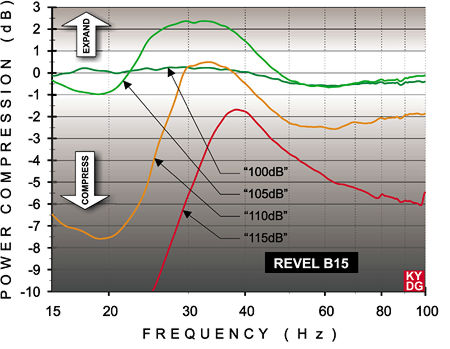
Fig. 2: Power Compression
There was evidence of severe compression below 30Hz at the higher playback levels. This was probably the result of an internal sliding highpass filter intended to protect the driver from damage and increase its dynamic response above the filter's corner frequency. This would seem consistent with the fact that the corner frequency moved up as I increased the drive level. The B15's swings, both positive and negative, away from linear dynamic response at the higher drive levels suggest a potential for introducing colorations, the audibility of which would depend on the nature of the program material.
The shaped tone-burst chart (Fig.3) reveals in greater detail how much short-term peak output the B15 managed at various frequencies just prior to the onset of audible distortion.
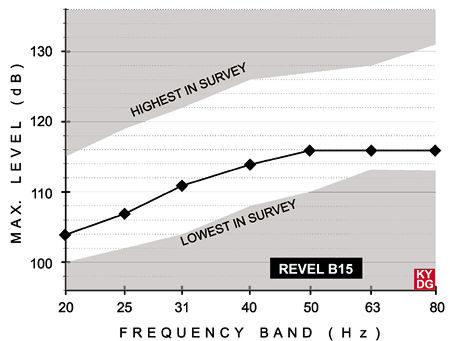
Fig. 3: Shaped Tone-burst Peak Output
Total harmonic distortion: The relatively short vertical bars in the total harmonic distortion (THD) graph (Fig.4) reveal the B15 to have been well-behaved above around 40Hz, even at let-'er-rip levels. In the octave below 40Hz, THD pushed well past 20% at the higher playback levels. The bars create something of a "valley" running from front to back at 40Hz, suggesting that program material in this range will be replayed especially cleanly.
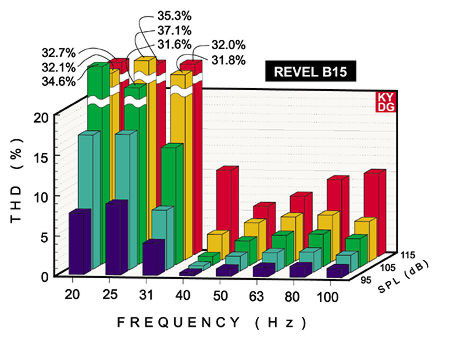
Fig. 4: Total Harmonic Distortion vs Frequency & Leve
Listening
On the first selection, "Jurassic Lunch," from Telarc's woofer-busting Great Fantasy Adventure Album CD, the dinosaur's final step at around 1:02 calls for high-level energy spread throughout the ground-shaking 10– 25Hz range. The Revel unit managed a peak of just under 100dB before distortion from this largely infrasonic event became an issue. Compared to the reference waterfall taken straight from the surround processor's subwoofer output (Fig.A1), the one taken by a calibrated microphone 2m from the B15 turned up to just shy of the onset of audible distortion (Fig.A2) shows that the Revel unit was not able to replay much of the sub-20Hz energy, nor was it able to reproduce the above-20Hz content at a level to rival the more energetic subs in the survey.
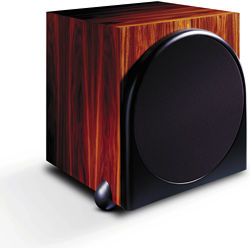 However, with the main left/right speakers reconnected, and the system hitting peaks of 110dB (with the sound level meter set to fast response and C weighting), the overall experience was realistic enough to have me recoiling in my lawn chair at the sound of the dino chomping and swallowing its squealing prey, emitting a valedictory belch, and clomping heavily away. I'm not sure I would have wanted it any more real than that.
However, with the main left/right speakers reconnected, and the system hitting peaks of 110dB (with the sound level meter set to fast response and C weighting), the overall experience was realistic enough to have me recoiling in my lawn chair at the sound of the dino chomping and swallowing its squealing prey, emitting a valedictory belch, and clomping heavily away. I'm not sure I would have wanted it any more real than that.
The depth charges in U-571 (Figs.B1 and B2) were brought off credibly, if not shatteringly. They would have seemed more impressive had I not experienced the same passage a few minutes earlier on the much larger and more expensive Genelec HTS6 (see below). The difference was partly a case of peak level capability (the B15 topped out at 109dB, the Genelec at 122dB on this passage), partly a case of how much deeper the Genelec plumbed bass's nether regions at the higher playback levels, partly a case of distortion levels, and largely a case of how all three of these factors played out in the perceptual domain. (Even a little bit more output capability in the lowest frequencies can be disproportionately important in subjective impact due to the way our ears operate as the frequency decreases.) It would take at least four Revel B15s to equal the HTS6's output on this track. That may sound like a disadvantage for the Revel, but consider that distributing two or more subs in a room would offer the very real prospect of generating a smoother overall pressure map due to the different efficiencies with which the subs couple to individual room modes.
The fire-up-the-choppers scene a little more than 35 minutes into Black Hawk Down (Figs.C1 and C2), seen as vertical stripes in the waterfall plot, calls for sustained, high-level engine and blade throbs at around 7, 18, 31, 43, and 55Hz. No sub I've ever measured has mustered enough grunt at 7Hz to have a hope of hitting the 103dB level required at that frequency to be barely audible. You can hear below 20Hz if the level is high enough. Human hearing does not suddenly cease at 20Hz, but the threshold is moved so high that very few devices can develop enough level to be audible to a listener 2m away. You might also experience some trouble with normal body functions in the presence of such energy! It's a different story at 18Hz, where the threshold of audibility is under 90dB. The B15 managed a peak of 101dB on this track before signaling distress. At that level, the 18Hz element wasn't perceptually present enough to create the in-your-gut effect that unlocks the scene's emotional power.
The bass drum on the Casper soundtrack album (concentrated heavily around 42Hz) sounded full and crisp through the B15, seeming to lack visceral impact and unforced feel only in direct comparison with the best performers in the survey (all of which are substantially larger than the Revel)—and even then, the differences were rather minor.
The Revel acquitted itself well on the remaining tracks. On Holly Cole's "Jersey Girl," from the Temptation CD, the string bass (strong down to about 35Hz on the program material, tapering off below that) sounded deep and firm, sans bloat or wooliness. "Flight of the Cosmic Hippo," from Béla Fleck's album of the same name, came across flawlessly, with a notably tight bass-drum sound, while the opening bass-drum whack in the famous Telarc recording of Holst's First Suite for Military Band (with peak energy just below 40Hz) was given near-textbook delivery up to 108dB, beyond which it progressively took on a soggy cardboard character, probably a function of distortion and compression.
The Bottom Line
The Revel B15 proved to be a capable performer at moderate to moderately loud playback levels, yielding little even to its most distinguished competitors. It began to lose its grip only under the most demanding, even punishing, circumstances. In fact, Kevin Voecks confirmed that Revel's standard recommendation is to use two units for home theater installations.
Under the microscope, the Revel Performa B15 doesn't take the prize in any particular performance category, but zooming out to see the big picture shows it to be a well-balanced package that should be short-listed for consideration in a variety of real-world applications. And the Revel's three-band parametric equalizer, not reviewed here [but proven very effective in our first review of the unit, in our May 2003 issue—Ed] adds to the appeal of the overall package.
Specifications
Revel Performa B15 powered subwoofer in sealed cabinet of 1"-thick MDF
Driver: 15" Kevlar-pulp-and-alloy composite cone, 130oz magnet assembly, 4-layer voice coil with 3" of peak-to-peak travel, cast aluminum frame
Frequency response: 20-80Hz, +/-0.5dB; –3dB at 18Hz
Inputs & outputs: XLR (balanced), RCA (single-ended)
Amplifier:1000W RMS
Highpass filter: 30–80Hz, 12 or 24dB/octave
Lowpass filter: 30–80Hz, 24 or 48dB/octave (defeatable)
Phase: continuously variable, 0–180°
Other: 3-band parametric equalizer, RCA and XLR pass-through outputs for looping to another B15
Weight: 105 lbs
Dimensions: 20.2" x 20.1" x 19.6" (WxHxD)
Finishes: black ash; add $300 for natural cherry or maple
Price: $2995
Revel
(781) 280-0300
www.revelspeakers.com




























































